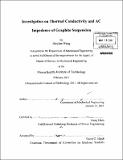| dc.contributor.advisor | Gang Chen. | en_US |
| dc.contributor.author | Wang, Jianjian, Ph. D. Massachusetts Institute of Technology | en_US |
| dc.contributor.other | Massachusetts Institute of Technology. Dept. of Mechanical Engineering. | en_US |
| dc.date.accessioned | 2011-08-18T19:17:56Z | |
| dc.date.available | 2011-08-18T19:17:56Z | |
| dc.date.copyright | 2011 | en_US |
| dc.date.issued | 2011 | en_US |
| dc.identifier.uri | http://hdl.handle.net/1721.1/65318 | |
| dc.description | Thesis (S.M.)--Massachusetts Institute of Technology, Dept. of Mechanical Engineering, 2011. | en_US |
| dc.description | Cataloged from PDF version of thesis. | en_US |
| dc.description | Includes bibliographical references (p. 82-89). | en_US |
| dc.description.abstract | Over the past decade, some groups have reported that nanofluids, which are liquids containing suspensions of nanoparticles, have substantially higher thermal conductivity than that of the base fluids. However, the reported high thermal conductivity sometimes cannot be reproduced. Theoretically, potential mechanisms leading to this enhancement are still under scrutiny. In this thesis, we present experimental studies aiming at understanding heat conduction mechanisms in nanofluids. We use graphite flakes as additives and developed methods to prepare stable graphite suspensions. The thermal conductivity enhancement of our suspensions achieved record high thermal conductivity values in different base fluids including water, engine oil, and ethylene glycol. This thesis investigates the effect of graphite flake preparation methods such as microwave and ultrasonic on the thermal conductivity of the suspensions, and found that graphite flakes of tens of nanometer in thickness but tens of microns in size lead to higher thermal conductivity values. To better understand the transport mechanisms, the electrical properties of graphite suspensions are also investigated using AC impedance spectroscopy. The AC impedance spectroscopy leads to insights on how the internal structures of the flake clusters affect heat conduction. Based on the experimental studies, we conclude that the thermal conductivity enhancement in these suspensions is due to percolation heat conduction along graphite flakes. | en_US |
| dc.description.statementofresponsibility | by Jianjian Wang. | en_US |
| dc.format.extent | 89 p. | en_US |
| dc.language.iso | eng | en_US |
| dc.publisher | Massachusetts Institute of Technology | en_US |
| dc.rights | M.I.T. theses are protected by
copyright. They may be viewed from this source for any purpose, but
reproduction or distribution in any format is prohibited without written
permission. See provided URL for inquiries about permission. | en_US |
| dc.rights.uri | http://dspace.mit.edu/handle/1721.1/7582 | en_US |
| dc.subject | Mechanical Engineering. | en_US |
| dc.title | Investigation on thermal conductivity and AC impedance of graphite suspension | en_US |
| dc.type | Thesis | en_US |
| dc.description.degree | S.M. | en_US |
| dc.contributor.department | Massachusetts Institute of Technology. Department of Mechanical Engineering | |
| dc.identifier.oclc | 745803791 | en_US |
